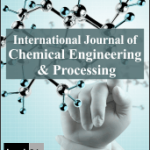Open Access

Johnson Oboh
- Senior Lecturer Department of Polymer Technology, Nigerian Institute of Leather and Science Technology Zaria Nigeria
Abstract
In this contribution, the uptake of water, methanol, acetone and toluene at ambient temperature by Coconut Shell-Filled Rubber Vulcanizates as a function of time were studied. The rubber vulcanizate with varying Coconut Shell filler (CSF) concentration of 10 to 50 pphr at 10 pphr interval was prepared using two roll mixing mill and compression moulding process. The effect of filler loading on the percentage uptake of different chemicals (water, methane, acetone and toluene) by rubber matrix vulcanizate were monitored. Results showed similar trends for water and methanol uptake by the vulcanizate such that, increasing CSF concentration in the vulcanizate and period of immersion from 24 to 72 hours resulted to slight increase from about 0.5 to 3 % in the amount of water and methanol uptake while reverse trends were exhibited for the period of immersion from 24–72 hours. However, the percentage water and methanol uptake by the filled vulcanizates is much lower compared to that of acetone and toluene at all CSF concentrations and periods of immersion. Hence the vulcanizate properties will be more stable water and methanol environments than that of toluene and acetone.
Keywords: Vulcanizate Chemical Resistance Coconut Shell Filler Natural Rubber Diffusion
[This article belongs to International Journal of Chemical Engineering and Processing(ijocep)]

Browse Figures
References
1. A. Lakshumu Naidu, V. Jagadeesh, M.V. A Raju Bahubalendruni. A review of chemical and physical properties of natural fibre reinforced composites. International Journal of Advanced Research in Engineering and Technology. 2017; 8(1): 56-68.
2. A.S Singha, Vijay Kumar Thakur. Chemical resistance, mechanical and physical properties of biofibers-based polymer composites. Polymer-Plastics Technology and Engineering. 2009; 48(7): 34-42.
3. Kanishka, bhunia, Shyam, S. Sabiani, et.al. Migration of chemical compounds from packaging polymers during microwave, conventional heat treatment and storage. Comprehensive Reviews in Food Science and Food Safety. 2013; 12(5): 423-545.
4. Ehsan Ghobadi, Axel Marquardt, Elias Mahmoudinezhad Zirdehi, et.al. The influence of water and solvent uptake on functional properties of shape-memory polymers. International Journal of Polymer Science. 2018; 2018.
5. Jae Kap Jung, Un Bong Baek, Seung Hoon Nahm, et.al. Hydrogen sorption and desorption properties in rubbery polymer. Material Chemistry and Physics. 2022; 279: 56-62.
6. Akinlabi, A.K., Okeimen, F.E., Aigbodion, A.I. Thermal ageing properties and chemical resistance of blends of natural rubber and epoxidized low molecular weight natural rubber. Journal of Applied Polymer Science. 2005; 98: 1733-1739.
7. E. Alfredo Campo. Microbial, Weather and Chemical resistance of polymeric materials. Plastic Design Library. 2008; 205-225.
8. Younus K Jabur. Effect of chemical solution on some of the mechanical properties of the polymer composites reinforced. JOUR. 2016; 91: 37947-37951.
9. Das Lala Sumit, Deoghare, Ashish B., Chatterjee, Sushovan. Effect of reinforcements on polymer matrix biocomposites “An Overview”. Science and Engineering of Composites Materials. 2018; 25(6): 1039-1058.
10. Eldho, A., Merin, S.T., Pothen, L.A., et.al. Green nanocomposite of natural rubber/cellulose: membrane transport, rheological and thermal characteristics. Journal of Industrial Crops and Product. 2013; 51: 415-424.
11. Robert, J.Y, Peter, A.I. Introduction to polymers. London: CRC press, Taylor & Francis group; 2011.
12. Colon Quintana Jose, Heckner, Tobias, Chrpapa, Achim, et.al. Experimental study of particle migration in polymer processing. Journal of Polymer Composites. 2019; 40(6): 2165-2177.
13. Mun-Gyu Bak, Jong Sung Won, Seon-Woog Koo, et.al. Migration behaviour of lubricants in polypropylene composites under accelerated thermal ageing. Polymers. 2021; 13(11): 1723-1730.
14. Alamri, H., Low, I, M. Mechanical properties and water absorption behaviour of recycled cellulose fibre reinforced epoxy composites. Journal of Polymer Testing. 2012; 31(5): 6220-6228.
15. Munoz, E., Manrique, J.A.G. Water absorption behaviour and its effect on the mechanical properties of flax fibre-reinforced bio-epoxy composites. International Journal of Polymer Science. 2015; 2015: 1-10.

International Journal of Chemical Engineering and Processing
| Volume | 7 |
| Issue | 2 |
| Received | January 29, 2022 |
| Accepted | February 4, 2022 |
| Published | January 7, 2023 |


